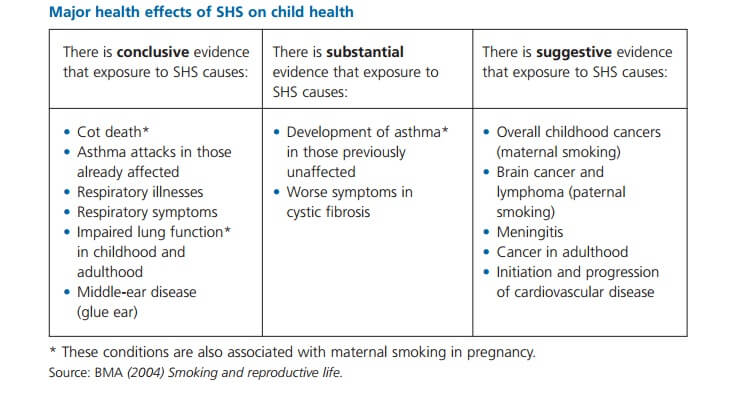Smoking Ban in Cars When Children Are Present: New Law Effective 1 October 2015
Smoking Ban in Cars When Children Are Present: New Law Effective 1 October 2015

On 1 October 2015 the government brought in a new law that made it an offence to smoke in a car in which children under 18 years of age were present. Second-hand smoke has been found to contain almost 4000 different chemicals, and smoking in confined areas such as a car has been found to concentrate these chemicals.
The Children and Families Act 2014 empowered the Secretary of State for Health to legislate against smoking in private cars when children are present. MPs passed the legislation by an overwhelming majority of 342 to 74 votes.
Public opinion and pressure from health charities and professionals created the momentum to bring the new legislation into force.
The details of the offence
Private vehicles must now be smoke-free if they are enclosed and there is anyone person present (other than the driver) who is under 18.
Under the new offence, both the driver and the smoker can be fined £50 on the spot – if any adult smokes in a car when children under 18 years of age are present. If someone commits an offence they could be issued with two fines.
The conditions of the offence are fairly strict, and will apply in the following situations:
- when the windows are fully or partially open
- when the sunroof is open
- when the air conditioning is on
- when the smoker is seated near an open car door
The new law does not apply when:
- the smoker is 17 and is alone in the car
- in a convertible car when the roof is completely down
- when e-cigarettes are smoked
The science behind the ban
According to a briefing to MPs provided by the British Lung Foundation in February 2014, passive smoking resulted in an almost 300,000 children requiring primary care and 10,000 hospital admissions every year1.
Although a number of parents do appear to make an attempt to reduce the effects of smoking on their children – by opening windows or turning on the fan or air conditioning, a 2007 US study2 revealed that significant levels of toxins remain in the vehicle.
The health impact of smoking in cars
Statistics released by the British Lung Foundation have revealed that over 430,000 children aged 11-15 in England are exposed to second-hand smoke in their family cars at least once a week.
Numerous studies have shown that second-hand smoking (SHS) or passive smoking (whether by breathing in smoke from a person’s cigarette or being exposed to surroundings or materials in a room where people have smoked) can result in health conditions.
These health conditions3 could include:
- headaches and dizziness
- eye irritation
- throat irritation, coughing
- breathing difficulties
- nausea
- stroke4
Regular exposure worsens the effect on a person’s health, with studies5 indicating a correlation between chronic exposure and serious health concerns such as:
- lung cancer
- chronic obstructive lung disease
- cardiovascular disease
The effect of second-hand smoke on children’ health
In a 2007 British Medical Association report6 on “Breaking the cycle of children’s exposure to tobacco smoke”, the effects of second-hand smoke on children were reported to be:

The BMA report concluded that a completely smoke-free home offered the best protection for children against SHS, and that damage-limitation measures were not effective:
“The evidence shows that only a completely smoke-free home offers effective protection from the health effects of SHS. Some studies have suggested that ‘harm reduction’ measures such as opening windows, smoking fewer cigarettes or avoiding smoking in the same room as children reduce levels of exposure to SHS. These studies also demonstrate that such measures still leave children exposed to levels of SHS that are far higher than those found in children who live in smoke-free homes, and in some cases are as high as those where there are no restrictions on smoking at all”.
The risks of smoking during pregnancy
The BMA report also highlighted the risks of second-hand smoke exposure to children in utero. These included:
“a modest increase in risk for specific foetal malformations, although the evidence is complex and difficult to interpret. The strongest evidence is for oral clefts (cleft lip and cleft palate). There is more limited evidence that smoking may be associated with absent or shortened limbs”.
For pregnant women, the advice from the BMA was clear: “No safe level of exposure to tobacco smoke during pregnancy has been identified.”
A 2015 You Gov poll7 revealed that 85% of adults in England supported a ban on smoking in cars carrying children. The poll also found that the ban was popular with smokers – with a surprising 74% supporting the new legislation.
With austerity measures and cuts in the number of officers affecting workload and effectiveness, the reaction from the police has been mixed. Steve White, chairman of the Police Federation described the enforcement of the smoking ban as “extremely challenging”
In a BBC Radio 4 Today programme, Mr White stated:
“The reality of the situation is we are struggling to attend burglaries. Should we be focusing on people smoking in cars with children in the cars or should we be focusing on burglaries?”
Taking into account guidance by the Department of Health – suggesting that a three-month ‘grace period’ be adopted, a National Police Chiefs’ Council spokeswoman said:
“Police forces will be taking an educational, advisory and non-confrontational approach when enforcing the new legislation. This would see people being given warnings rather than being issued with fines, which would give time for public awareness of the offences to build.”
The use of a three-month ‘grace period’ when implementing a ban on using mobile phones when driving (December 2003), set a precedent that allowed both law enforce agencies and the public to adapt to the new legislation.
Conclusion
Police and Councils took a similar approach to enforcement when the 2007 ban on smoking in enclosed public places was introduced. Enforcement was not a priority but the ban did lead to a change in attitudes and behaviour. The police do not have the resources to target such offences and the minimal fine compared to the amount of time and paperwork involved is unlikely to change the approach from educational and advisory but whether the existence of the law alone will see a further change in attitude to the social acceptability of smoking remains to be seen.
Contact our experienced road traffic offences solicitors for expert advice
If you are facing a road traffic prosecution, the most important thing you can do is to get early legal advice. But what you must not do is ask someone else to take your points for you, nor attempt to ignore correspondence and hope it all goes away, or try to throw together your own defence from a combination of urban myth and Google, as that is likely to make matters far worse.
To discuss your driving or road traffic offence please do not hesitate to contact driving offences solicitor, Caroline Dunne on 01895 207928 or our 24 hour line 0330 999 4999 for immediate help. Alternatively, email us at roadtraffic@ibblaw.co.uk.
References
1.Passive smoking and children: A report by the Tobacco Advisory Group. Royal College of Physicians, 2010.
2.Ott W, Klepeis N, Switzer P. Air change rates of motor vehicles and in-vehicle pollutant concentrations from secondhand smoke. Journal of Exposure Science and Environmental Epidemiology, 2007;18: 312-325.
3.Tobacco smoke and involuntary smoking. IARC Monographs on the evaluation of carcinogenic risks to humans. Vol 83. Lyon, France, 2004.
4.Oono, I.P., D.F. Mackay, and J.P. Pell, Meta-analysis of the association between secondhand smoke exposure and stroke. Journal of Public Health, 2011. 33(4): p. 496-502
5.Going smoke-free. The medical case for clean air in the home, at work and in public places. Chapter 2: Health effects of environmental tobacco smoke. RCP, 2005.
6.BMA Board of Science and Education. Breaking the cycle of children’s exposure to tobacco smoke. London, British Medical Association, 2007
7.YouGov survey. Total sample size was 10017 adults in England. Fieldwork was undertaken between 26th February to 12th March 2015. The survey was carried out online. The figures have been weighted and are representative of all GB adults (aged 18+).
